
St. Louis flooding: Historic Flooding Hits St. Louis. Emergency Responders and Local Authorities Struggle to Manage the Scale of Damage
St. Louis flooding: Historic Flooding Hits St. Louis. Emergency Responders and Local Authorities Struggle to Manage the Scale of Damage
St. Louis, Missouri, is grappling with some of the most severe flooding in recent history as torrential rainfall over the past 24 hours has overwhelmed the city’s infrastructure, causing widespread destruction, leaving countless residents stranded, and prompting urgent rescues. The relentless rains began late Monday night and have persisted into Tuesday, turning streets into rivers, submerging vehicles, flooding homes and businesses, and leaving whole neighborhoods under water.
Torrential Downpour Triggers Flooding Chaos
The National Weather Service (NWS) recorded rainfall amounts exceeding six inches in some areas of St. Louis within a few short hours. This intense deluge has strained the city’s storm drain systems beyond capacity, resulting in water surges across roads, parking lots, and public spaces. What began as scattered downpours quickly escalated into continuous, heavy rainfall, contributing to flash floods in vulnerable areas and rising water levels along major waterways like the Mississippi and Meramec Rivers, both of which run close to St. Louis and its surrounding communities.
The rapid accumulation of rainfall has been exacerbated by the fact that the region was already saturated from previous rain, leaving little capacity in the ground to absorb additional water. This combination of factors created a perfect storm for widespread flooding, overwhelming both natural and man-made drainage channels across St. Louis.
Impacted Areas: Neighborhoods Submerged, Roads Closed, and Infrastructure Compromised
Floodwaters have spread across much of St. Louis and its neighboring communities, transforming once-familiar streets into hazardous waterways. Several areas have been hit particularly hard:
- Downtown St. Louis: In the heart of the city, multiple streets are completely submerged, with floodwaters reaching several feet in some places. Many buildings in low-lying downtown areas have flooded basements and first floors, including popular shops, restaurants, and office buildings. Local businesses are reporting substantial property damage, while residents in apartment complexes and townhouses are facing flooded ground floors and basements.
- Residential Neighborhoods: Communities such as Carondelet, Tower Grove, and Forest Park are among those most heavily impacted, with residential streets impassable due to high water. In some places, floodwaters have risen to waist level, making it dangerous for residents to remain in their homes. Dozens of people have been forced to abandon their residences, leaving behind prized belongings. In these areas, the local fire department and emergency personnel have been conducting boat rescues to bring stranded residents to safety.
- Suburbs and Outlying Communities: St. Louis County and surrounding suburbs have also experienced severe flooding. In Brentwood, Richmond Heights, and Kirkwood, streets are underwater, and numerous homes and businesses have been affected. Emergency responders have been inundated with calls for assistance from residents trapped by rapidly rising floodwaters.
- Public Transportation Disruptions: St. Louis’s public transit system has also been hit hard. MetroLink trains, the city’s light rail system, have suspended services in several locations due to submerged tracks, and MetroBus routes are heavily delayed or rerouted. Many commuters who rely on public transit have been stranded, unable to reach their destinations. Buses in service have struggled to navigate flooded roadways, while others have stalled in high water.
Infrastructure Strains: Road Closures, Power Outages, and Water Contamination Concerns
The scale of flooding has placed immense pressure on St. Louis’s infrastructure. Numerous roads and highways are impassable, particularly along routes leading into and out of the downtown area. Major roadways, including parts of Interstate 70 and Interstate 64, have seen sections closed due to high water levels. Traffic bottlenecks are causing further complications, especially for emergency responders trying to access the most severely affected areas.
The combination of flooding and power outages has added another layer of complexity. Utility companies, including Ameren Missouri, have reported several power outages across the metropolitan area, with thousands of residents without electricity as crews work to repair flooded electrical substations and transformers. Power restoration efforts are underway, but officials warn that some residents may remain without electricity for extended periods as repairs progress.
There are also mounting concerns regarding water quality, as floodwaters can carry contaminants, including sewage and industrial waste. Local officials are advising residents to avoid contact with standing water wherever possible and to boil tap water before consumption until further notice.
Emergency Services on High Alert: Urgent Rescues and Relief Operations
With water levels continuing to rise in several parts of St. Louis, emergency response teams have mobilized in full force. Firefighters, police officers, and National Guard units have been deployed to assist in search and rescue operations, with boats being used in several neighborhoods to rescue residents from flooded homes and vehicles. The fire department has reported dozens of successful rescues so far, but many residents remain trapped.
In an effort to reach those in immediate danger, the St. Louis Fire Department has established temporary command centers in key locations across the city, coordinating efforts between local emergency responders, medical personnel, and volunteers. Helicopter rescues are also being considered for particularly hard-to-reach areas. St. Louis’s 911 call centers have been inundated with requests for assistance, leading to extended wait times as dispatchers prioritize the most urgent cases.
For residents forced to evacuate, the city has established temporary shelters at community centers, schools, and churches across St. Louis. Volunteers and Red Cross personnel are working to provide essentials, including food, water, and bedding, to displaced individuals and families. These shelters are expected to remain open for the foreseeable future, as many residents will be unable to return home until floodwaters recede and safety inspections are conducted.
Local Officials Address Flooding Crisis
St. Louis Mayor Tishaura Jones has spoken out about the flooding, reassuring the public that the city is doing everything possible to assist those affected. In a press conference held Tuesday afternoon, Jones stated, “This is a heartbreaking situation for our city. The unprecedented rainfall has put our residents in harm’s way, and we are doing all we can to provide help and resources to those impacted. My thoughts are with everyone affected by these devastating floods.”
Missouri Governor Mike Parson has declared a state of emergency, freeing up additional resources for St. Louis and neighboring communities. National Guard units have been activated to support local rescue operations and to assist with evacuations, sandbagging, and security in flood-prone areas. State officials are also coordinating with federal agencies, including the Federal Emergency Management Agency (FEMA), to determine potential avenues for federal relief funding to help with recovery and rebuilding efforts.
Public Safety Recommendations: Staying Safe During Flooding
As flood conditions continue to develop, local authorities are urging St. Louis residents to exercise extreme caution. Public safety recommendations include:
- Avoid driving or walking through flooded areas, as even shallow water can be dangerous and fast-moving currents can sweep people and vehicles away. Emergency officials are emphasizing the phrase “Turn Around, Don’t Drown” to remind drivers of the risks associated with flooded roadways.
- Stay indoors if possible and avoid contact with floodwater, which may be contaminated with hazardous chemicals or sewage.
- Monitor weather updates and follow instructions from local officials. The National Weather Service is maintaining a close watch on weather patterns and will continue to issue flood warnings as necessary.
- Prepare for potential evacuation, especially if residing in low-lying areas prone to flooding. Residents are advised to have essential items ready, including medications, important documents, and personal identification, in case they need to evacuate quickly.
A Look at Climate and Infrastructure Challenges in St. Louis
The current flooding in St. Louis has drawn renewed attention to the region’s susceptibility to extreme weather events and infrastructure challenges. In recent years, the frequency and severity of flooding incidents in Missouri and surrounding states have increased, a trend many scientists attribute to climate change. Rising global temperatures can lead to more extreme and unpredictable weather patterns, such as the intense, prolonged rainfall St. Louis is currently experiencing.
The city’s drainage and stormwater systems, designed decades ago, are struggling to cope with these new climate realities. Local leaders are now facing calls to modernize the infrastructure to better withstand heavy rainfall and prevent the widespread disruptions seen today. Efforts to address these issues, however, will require significant funding and coordination across multiple government agencies.
Long-Term Recovery: Rebuilding and Preventing Future Flooding
As floodwaters begin to recede in the coming days, St. Louis will face the daunting task of recovery. For affected residents, the immediate focus will be on salvaging belongings, repairing damaged property, and returning to a sense of normalcy. For businesses, the flooding has disrupted operations and left many with costly repairs. Insurance claims are expected to surge, and local government agencies will be assessing the extent of the financial impact.
Rebuilding and flood-proofing St. Louis will require collaborative efforts from city planners, government officials, and environmental experts. Long-term solutions could include upgrading stormwater management systems, creating more green spaces to absorb excess water, and enhancing levee protections around vulnerable neighborhoods.
Conclusion: A Resilient Community Responds to Disaster
As St. Louis continues to grapple with the aftermath of this historic flooding, the city’s resilience and sense of community remain strong. Volunteers have mobilized to assist in relief efforts, and neighbors are working together to support each other in this challenging time. The immediate focus remains on rescuing those still in danger, assisting displaced residents, and restoring essential services. The city and state leadership are committed to protecting public safety and rebuilding with a forward-thinking approach



